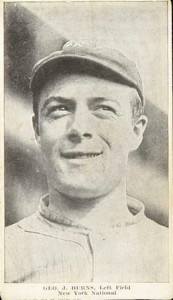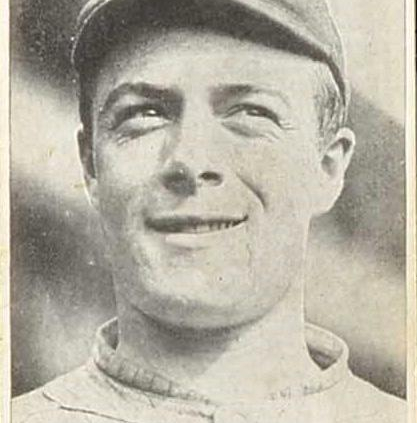George Burns
 Not to be confused with the American League first baseman or the cigar-wielding comedian of the same name, who were roughly his contemporaries, George Burns of the National League was the most consistent hitter in major-league history, batting .287 for his 15-year career, but never higher than .303 nor lower than .272 in a full season. Though Burns is hardly remembered today, John McGraw described him as “one of the most valuable ball players that ever wore the uniform of the Giants.” He consistently ranked among the NL leaders in hits, runs, walks, and stolen bases. George was tremendously strong even though he stood just 5’7″ and weighed only 160 lbs.; an excellent boxer and wrestler, he was one of the Giants who couldn’t resist challenging the much larger Jim Thorpe to wrestling matches before McGraw forbade the practice. He also demonstrated his strength by wielding a 42″, 52-oz. bat, which was a tree trunk even by Deadball Era standards.
Not to be confused with the American League first baseman or the cigar-wielding comedian of the same name, who were roughly his contemporaries, George Burns of the National League was the most consistent hitter in major-league history, batting .287 for his 15-year career, but never higher than .303 nor lower than .272 in a full season. Though Burns is hardly remembered today, John McGraw described him as “one of the most valuable ball players that ever wore the uniform of the Giants.” He consistently ranked among the NL leaders in hits, runs, walks, and stolen bases. George was tremendously strong even though he stood just 5’7″ and weighed only 160 lbs.; an excellent boxer and wrestler, he was one of the Giants who couldn’t resist challenging the much larger Jim Thorpe to wrestling matches before McGraw forbade the practice. He also demonstrated his strength by wielding a 42″, 52-oz. bat, which was a tree trunk even by Deadball Era standards.
The son of John Burns, who ironically was a cigar maker, George Joseph Burns was born in Utica, New York, on November 24, 1889. The elder Burns also ran a pool hall where George worked as a boy and learned how to handle a cue (in later years other Giants wouldn’t play him in pool unless he agreed to play left-handed). The younger Burns also played sandlot baseball in the Utica area, usually pitching or catching “so that I could get as much action as possible,” he recalled. On October 18, 1908, George and his father were in the grandstand at the Utica Athletic Field for an exhibition game between the Syracuse Stars and the Utica Harps of the New York State League. The Utica catcher didn’t show up and Harps manager Charley Dooley asked George, a well-known semipro, to fill in. After the game, Dooley signed him up for the following spring.
Burns played primarily catcher for Utica for the next two seasons until new manager Charlie Carr switched him to right field in 1911. McGraw’s old Baltimore Orioles teammate Sadie McMahon, scouting for the Giants, spotted Burns and recommended that McGraw sign the speedy outfielder, who batted .289 with 40 stolen bases that season. Utica and the Giants closed the deal for $4,000 and George made his major-league debut on October 3, 1911, as a late-inning substitute. He got into five more games that fall, notching the first of his 2,077 hits on the last day of the season. The next year McGraw decided to keep Burns on the bench rather than farming him out to a minor-league team, a common practice for the Giants manager, who liked to bring his players along slowly. “You may not play much this year but I want you with me,” explained McGraw during spring training. “You sit next to me on the bench and I’ll tell you all I can about the way they play ball up here. And I’ll stick you in there now and then to give you some experience. I don’t want you to get impatient. Understand?” The well-behaved, soft-spoken rookie just nodded. That year he played in 29 games, batting .294 with seven stolen bases.
In 1913 the 23-year-old Burns became McGraw’s Opening Day left fielder, displacing speedy leadoff hitter Josh Devore, who had fallen out of favor and soon would be traded. Left field in the Polo Grounds was a notoriously difficult position on bright, sunny afternoons, and Devore had lost fly balls in the sun too frequently for McGraw’s liking. Determined not to make the same mistake, Burns worked hard to become a specialist at playing the sun field, in time adopting a special cap with an extra long bill and blue sunglasses attached to it (at the plate he switched to a short-billed cap). Sportswriters dubbed the left-field bleachers “Burnsville” as the pint-sized speedster rapidly established himself as a fan favorite. Initially batting third in the order, George moved to leadoff at midseason and became known as a cleverer base runner than his teammates, even though the Giants as a team were noted for their daring base running. Playing in 150 games, Burns batted .286 and finished second in the NL in doubles (37), third in hits (173), and fourth in stolen bases (40).
Moving back to the three-hole in 1914, Burns enjoyed his greatest season, finishing fourth in that year’s Chalmers Award voting and earning a spot on Baseball Magazine’s National League All-America team for the first time (he also made the team each season from 1917 to 1919). He batted a career-high .303 and led the NL in runs scored (100) and stolen bases (a career-high 62). Burns also ranked second in the NL in hits (tied with Zack Wheat at 170) and on-base percentage (.403), and third in doubles (35) and bases on balls (89). On October 7, 1914, George married Mary Baker of New York City. The following day, playing in the first game of the city championship series against the Yankees, he became “a bit frustrated,” according to the New York Times, when the band played a wedding march as he stepped to the plate. “He got over it quickly and made a holiday of his first day of wedded bliss,” the Times continued. Burns notched four hits and stole two bases in the Giants victory.
Starting in 1915 George Burns was the Giants leadoff hitter for the rest of his stay in Manhattan. The denizens of Burnsville were rarely disappointed, as their hero almost never missed a game; from 1915 to 1917 he played in 459 consecutive games, then a record for an outfielder. Burns’ worst season was 1915 when he batted a career-low .272 and the Giants finished last. Referring back to that season, George once said, “When a player criticizes some other player’s work in his wife’s hearing, she may mention it casually to that other player’s wife. The glad news spreads and grows and pretty soon there will be four or five fellows on the ball club looking at one another out of the corner of one eye and reaching for a bat when they meet on the bench. I remember one club where the manager sent away all the players’ wives. They talked so much and created so much ill feeling on the club that he wouldn’t have them around.”
Burns bounced back to lead the NL in runs scored in 1916 and 1917, and during the latter season he also led the NL with 75 bases on balls. He went on to lead the league in walks five times in seven years, peaking with 101 in 1923. Apparently it took George several years to acquire his plate discipline; in his rookie season of 1913, sportswriter Hugh Fullerton wrote, “Burns looks odd on the New York team because of the quick, business-like manner he uses in batting. He walks right up and hits, as if in a hurry to get it over.”
In 1919 Burns tied his career high in batting average (.303) and led the NL in on-base percentage (.396) and stolen bases (40); for his career he stole home 28 times, which is third on the all-time list behind Ty Cobb and Max Carey. George set career highs in runs (115) and hits (181) in 1920, and he remained a fixture in left field for the Giants until midseason 1921, when he moved to center to make room for Irish Meusel. His performance in that year’s World Series was his best of the three in which he participated. Burns batted .333 for the victorious Giants, collecting 11 hits in all (four in Game Three alone), five of them for extra bases. His biggest clout was a game-winning, two-run double in Game Four. Surprisingly, the 1921 World Series proved to be Burns’ last appearance in the Giants lineup.
On December 6, 1921, McGraw traded Burns, catcher Mike Gonzalez, and $150,000 to the Cincinnati Reds for Heinie Groh. The news caught George by surprise but he bore no hard feelings. New York expressed its gratitude for his decade of service by holding a “George Burns Day” on June 10, 1922. As part of the ceremonies, the Giants hoisted their 1921 World Championship flag with Burns (in his Cincinnati uniform) leading the procession. Playing center and right, the sun fields at Redland Field, George continued to perform up to his customary standard with Cincinnati in 1922-23, not missing a single game in either season as the Reds finished second to the Giants in both years. He slipped a notch in 1924, however, and in 1925 the Phillies acquired him for the waiver price. The 35-year-old outfielder batted .292 in 88 games in his final major-league campaign.
Burns continued as an active player in the minor leagues through 1930. In 1926 he played in 163 games for Newark and led the International League in doubles (49) and stolen bases (38). The following two years he was player-manager for Williamsport of the New York-Pennsylvania league, finishing out the 1928 season with 18 games as player-manager for Hanover of the Blue Ridge League. In 1931, his last year in baseball, George returned to the Polo Grounds as a coach for McGraw’s Giants. In retirement he returned to Gloversville, New York, just outside of Utica, and ran his father’s pool hall for a time, then became the payroll clerk at a tannery. Occasionally Burns played first base for local semipro teams. On October 18, 1952, George was married a second time, to Pauline Rezek. After retiring in 1957, he lived quietly in Gloversville until his death at age 76 on August 15, 1966.
Note: A slightly different version of this biography appeared in Tom Simon, ed., Deadball Stars of the National League (Washington, D.C.: Brassey’s, Inc., 2004).
Sources
For this biography, the author used a number of contemporary sources, especially those found in the subject’s file at the National Baseball Hall of Fame Library.
Full Name
George Joseph Burns
Born
November 24, 1889 at Utica, NY (USA)
Died
August 15, 1966 at Gloversville, NY (USA)
If you can help us improve this player’s biography, contact us.


